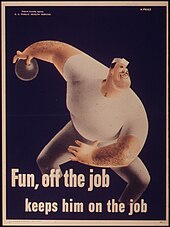

Fun is defined by the Oxford English Dictionary as "light-hearted pleasure, enjoyment, or amusement; boisterous joviality or merrymaking; entertainment". [1]


Fun is defined by the Oxford English Dictionary as "light-hearted pleasure, enjoyment, or amusement; boisterous joviality or merrymaking; entertainment". [1]
The word fun is associated with sports, entertaining media, high merriment, [2] and amusement. Although its etymology is uncertain, [1] it has been speculated that it may be derived from Middle English fonne (fool) and fonnen (the one fooling the other). [3] An 18th century meaning (still used in Orkney and Shetland [1] ) was "cheat, trick, hoax", a meaning still retained in the phrase "to make fun of". [4]
The landlady was going to reply, but was prevented by the peace-making sergeant, sorely to the displeasure of Partridge, who was a great lover of what is called fun, and a great promoter of those harmless quarrels which tend rather to the production of comical than tragical incidents.
Henry Fielding, The History of Tom Jones, a Foundling (1749) [5]
The way the word fun is used demonstrates its distinctive elusiveness and happiness. Expressions such as "Have fun!" and "That was fun!" indicate that fun is pleasant, personal, and to some extent unpredictable. Expressions such as "I was making fun of myself" convey the sense that fun is something that can be amusing and not to be taken seriously. The adjective "funny" has two meanings, which often need to be clarified between a speaker and listener. One meaning is "amusing, jocular, droll" and the other meaning is "odd, quirky, peculiar". These differences indicate the evanescent and experiential nature of fun and the difficulty of distinguishing "fun" from "enjoyment". [6]
Fun's evanescence can be seen when an activity regarded as fun becomes goal-oriented. Many physical activities and individual sports are regarded as fun until the participant seeks to win a competition, at which point, much of the fun may disappear as the individual's focus tightens. Surfing is an example. If you are a "mellow soul" (not in a competition or engaging in extreme sport) "once you're riding waves, you're guaranteed to be having fun". [7]
The pleasure of fun can be seen by the numerous efforts to harness its positive associations. For example, there are many books on serious subjects, about skills such as music, mathematics and languages, normally quite difficult to master, which have "fun" added to the title. [8] [9] [10]
Many physical activities provide opportunities to play and have fun. Not only can these activities be fun, but can also improve physical and mental states.

According to Johan Huizinga, fun is "an absolutely primary category of life, familiar to everybody at a glance right down to the animal level." [11] Psychological studies reveal both the importance of fun and its effect on time perception, which is sometimes said to be shortened when one is having fun. [12] [13] As the adage states: "Time flies when you're having fun".
It has been suggested that games, toys, and activities perceived as fun are often challenging in some way. When a person is challenged to think consciously, overcome challenge and learn something new, they are more likely to enjoy a new experience and view it as fun. A change from routine activities appears to be at the core of this perception, since people spend much of a typical day engaged in activities that are routine and require limited conscious thinking. Routine information is processed by the brain as a "chunked pattern": "We rarely look at the real world", according to game designer Raph Koster, "we instead recognize something we have chunked, and leave it at that. [...] One might argue that the essence of much of art is in forcing us to see things as they really are rather than as we assume them to be". [14] Since it helps people to relax, fun is sometimes regarded as a "social lubricant", important in adding "to one's pleasure in life" and helping to "act as a buffer against stress". [15]
For children, fun is strongly related to play and they have great capacity to extract the fun from it in a spontaneous and inventive way. Play "involves the capacity to have fun – to be able to return, at least for a little while, to never-never land and enjoy it." [15]
Some scientists have identified areas of the brain associated with the perception of novelty, which are stimulated when faced with "unusual or surprising circumstances". Information is initially received in the hippocampus, the site of long-term memory consolidation, where the brain attempts to match the new information with recognizable patterns stored in long-term memory. When it is unable to do this, the brain releases dopamine, a chemical which stimulates the amygdala, the site of emotion, and creates a pleasurable feeling that is associated with the new memory. [16] In other words, fun is created by stimulating the brain with novelty.
With the emergence of entertainment industry, fun is sold as a consumer product in the form of games, novelties, television, toys and other amusements. Marxist sociologists such as the Frankfurt School criticise mass-manufactured fun as too calculated and empty to be fully satisfying.[ citation needed ] Bill Griffith satirises this dysphoria when his cartoon character Zippy the Pinhead asks mechanically, "Are we having fun yet?" In The Beatles song "She's Leaving Home" fun is called "the one thing that money can't buy." [17]

Perception is the organization, identification, and interpretation of sensory information in order to represent and understand the presented information or environment. All perception involves signals that go through the nervous system, which in turn result from physical or chemical stimulation of the sensory system. Vision involves light striking the retina of the eye; smell is mediated by odor molecules; and hearing involves pressure waves.
Pleasure is experience that feels good, that involves the enjoyment of something. It contrasts with pain or suffering, which are forms of feeling bad. It is closely related to value, desire and action: humans and other conscious animals find pleasure enjoyable, positive or worthy of seeking. A great variety of activities may be experienced as pleasurable, like eating, having sex, listening to music or playing games. Pleasure is part of various other mental states such as ecstasy, euphoria and flow. Happiness and well-being are closely related to pleasure but not identical with it. There is no general agreement as to whether pleasure should be understood as a sensation, a quality of experiences, an attitude to experiences or otherwise. Pleasure plays a central role in the family of philosophical theories known as hedonism.

In conventional usage, boredom, ennui, or tedium is an emotion characterized by uninterest in one's surrounding, often caused by a lack of distractions or occupations. Although, "There is no universally accepted definition of boredom. But whatever it is, researchers argue, it is not simply another name for depression or apathy. It seems to be a specific mental state that people find unpleasant—a lack of stimulation that leaves them craving relief, with a host of behavioral, medical and social consequences." According to BBC News, boredom "...can be a dangerous and disruptive state of mind that damages your health"; yet research "...suggest[s] that without boredom we couldn't achieve our creative feats."

Sexual stimulation is any stimulus that leads to, enhances and maintains sexual arousal, and may lead to orgasm. Although sexual arousal may arise without physical stimulation, achieving orgasm usually requires it.

Curiosity is a quality related to inquisitive thinking such as exploration, investigation, and learning, evident in humans and animals. Curiosity helps human development, from which derives the process of learning and desire to acquire knowledge and skill.
Motivational salience is a cognitive process and a form of attention that motivates or propels an individual's behavior towards or away from a particular object, perceived event or outcome. Motivational salience regulates the intensity of behaviors that facilitate the attainment of a particular goal, the amount of time and energy that an individual is willing to expend to attain a particular goal, and the amount of risk that an individual is willing to accept while working to attain a particular goal.
Kinesthetic learning, kinaesthetic learning, or tactile learning is learning that involves physical activity. As cited by Favre (2009), Dunn and Dunn define kinesthetic learners as students who prefer whole-body movement to process new and difficult information. However, scientific studies do not support the claim that using kinesthetic modality improves learning in students identified as kinesthetic learning as their preferred learning style.

Raphael "Raph" Koster is an American entrepreneur, game designer, and author of A Theory of Fun for Game Design. Koster is widely recognized for his work as the lead designer of Ultima Online and the creative director behind Star Wars Galaxies. From 2006 until 2013 he worked as the founder and president of Metaplace producing a Facebook game platform.
Some philosophers, such as Jeremy Bentham, Baruch Spinoza, and Descartes, have hypothesized that the feelings of pain and pleasure are part of a continuum.
Sensory processing is the process that organizes and distinguishes sensation from one's own body and the environment, thus making it possible to use the body effectively within the environment. Specifically, it deals with how the brain processes multiple sensory modality inputs, such as proprioception, vision, auditory system, tactile, olfactory, vestibular system, interoception, and taste into usable functional outputs.
The hedonic treadmill, also known as hedonic adaptation, is the observed tendency of humans to quickly return to a relatively stable level of happiness despite major positive or negative events or life changes.

The lateralization of brain function is the tendency for some neural functions or cognitive processes to be specialized to one side of the brain or the other. The median longitudinal fissure separates the human brain into two distinct cerebral hemispheres, connected by the corpus callosum. Although the macrostructure of the two hemispheres appears to be almost identical, different composition of neuronal networks allows for specialized function that is different in each hemisphere.

The reward system is a group of neural structures responsible for incentive salience, associative learning, and positively-valenced emotions, particularly ones involving pleasure as a core component. Reward is the attractive and motivational property of a stimulus that induces appetitive behavior, also known as approach behavior, and consummatory behavior. A rewarding stimulus has been described as "any stimulus, object, event, activity, or situation that has the potential to make us approach and consume it is by definition a reward". In operant conditioning, rewarding stimuli function as positive reinforcers; however, the converse statement also holds true: positive reinforcers are rewarding.

Euphoria is the experience of pleasure or excitement and intense feelings of well-being and happiness. Certain natural rewards and social activities, such as aerobic exercise, laughter, listening to or making music and dancing, can induce a state of euphoria. Euphoria is also a symptom of certain neurological or neuropsychiatric disorders, such as mania. Romantic love and components of the human sexual response cycle are also associated with the induction of euphoria. Certain drugs, many of which are addictive, can cause euphoria, which at least partially motivates their recreational use.

Frisson, also known as aesthetic chills or psychogenic shivers, is a psychophysiological response to rewarding stimuli that often induces a pleasurable or otherwise positively-valenced affective state and transient paresthesia, sometimes along with piloerection and mydriasis . The sensation commonly occurs as a mildly to moderately pleasurable emotional response to music with skin tingling; piloerection and pupil dilation not necessarily occurring in all cases.

Desires are states of mind that are expressed by terms like "wanting", "wishing", "longing" or "craving". A great variety of features is commonly associated with desires. They are seen as propositional attitudes towards conceivable states of affairs. They aim to change the world by representing how the world should be, unlike beliefs, which aim to represent how the world actually is. Desires are closely related to agency: they motivate the agent to realize them. For this to be possible, a desire has to be combined with a belief about which action would realize it. Desires present their objects in a favorable light, as something that appears to be good. Their fulfillment is normally experienced as pleasurable in contrast to the negative experience of failing to do so. Conscious desires are usually accompanied by some form of emotional response. While many researchers roughly agree on these general features, there is significant disagreement about how to define desires, i.e. which of these features are essential and which ones are merely accidental. Action-based theories define desires as structures that incline us toward actions. Pleasure-based theories focus on the tendency of desires to cause pleasure when fulfilled. Value-based theories identify desires with attitudes toward values, like judging or having an appearance that something is good.
The hedonic music consumption model was created by music researchers Kathleen Lacher and Richard Mizeski in 1994. Their goal was to use this model to examine the responses that listening to rock music creates, and to find if these responses influenced the listener's intention to later purchase the music. The article begins with a discussion of why the issue of music consumption is important. Music is then explored as an aesthetic product, prior to a discussion of what hedonic consumption is, as well as its origins, and concludes with an in-depth look at the model itself.
As long as humans have experienced pain, they have given explanations for its existence and sought soothing agents to dull or cease painful sensations. Archaeologists have uncovered clay tablets dating back as far as 5,000 BC which reference the cultivation and use of the opium poppy to bring joy and cease pain. The Greek writer Homer's The Odyssey, written in 800 BC, features the character of Telemachus using opium to soothe his pain and forget his worries. While some cultures researched analgesics and allowed or encouraged their use, others perceived pain to be a necessary, integral sensation. Physicians of the 19th century used pain as a diagnostic tool, theorizing that a greater amount of personally perceived pain was correlated to a greater internal vitality, and as a treatment in and of itself, inflicting pain on their patients to rid the patient of evil and unbalanced humors.
Hedonic motivation refers to the influence of a person's pleasure and pain receptors on their willingness to move towards a goal or away from a threat. This is linked to the classic motivational principle that people approach pleasure and avoid pain, and is gained from acting on certain behaviors that resulted from esthetic and emotional feelings such as: love, hate, fear, joy, etc. According to the hedonic principle, our emotional experience can be thought of as a gauge that ranges from bad to good and our primary motivation is to keep the needle on the gauge as close to good as possible.

Consciousness after death is a common theme in society and culture, and the belief in some form of life after death is a feature of many religions. However, scientific research has established that the physiological functioning of the brain, the cessation of which defines brain death, is closely connected to mental states.
Just being content or satisfied may not make time fly, but being excited or actively pursuing a desired object can.